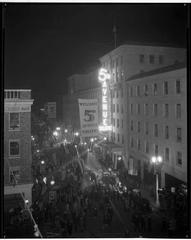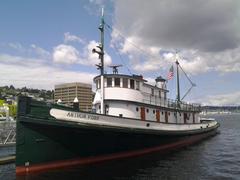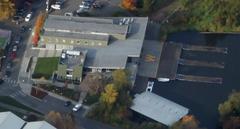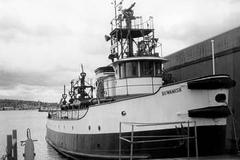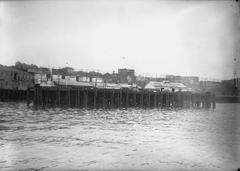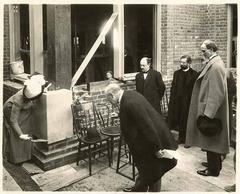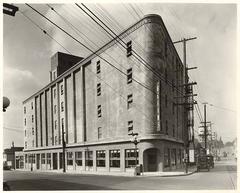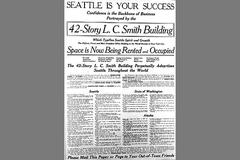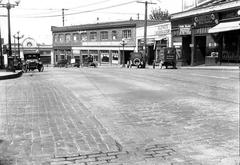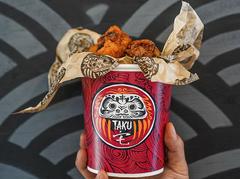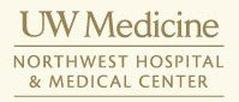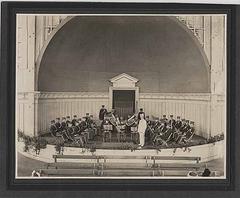Prefontaine Fountain Seattle: Visiting Hours, Tickets, and Historical Sites Guide
Date: 03/07/2025
Introduction
Prefontaine Fountain, nestled in the heart of Seattle’s historic Pioneer Square, is more than just a decorative landmark—it’s a living testament to the city’s origins, civic generosity, and community spirit. Located at the intersection of 3rd Avenue and Yesler Way, this elegant fountain draws visitors eager to connect with Seattle’s early days and its ongoing story as a vibrant, diverse metropolis. Whether you’re a history enthusiast, a local resident, or a traveler exploring Seattle historical sites, this comprehensive guide provides everything you need to make the most of your visit, including historical context, practical visitor information, accessibility tips, and insights into nearby attractions.
Table of Contents
- Discover Prefontaine Fountain: A Historic Seattle Landmark
- Cultural and Civic Significance
- Architectural and Artistic Value
- Visitor Information and Travel Tips
- Symbolism and Identity
- Role in Contemporary Civic Life
- Educational and Interpretive Value
- FAQ
- Summary and Visit Tips for Prefontaine Fountain
- References and Further Reading
Discover Prefontaine Fountain: A Historic Seattle Landmark
Historical Background
Early Land History and Origins
Prefontaine Fountain sits on what was once known as Yesler Triangle, a small parcel at the crossroads of early Seattle development. Originally deeded to the city in 1912 for a library, the land was repurposed for public use after being deemed too small for that purpose. The area, shaded by native trees and traversed by a creek, was close to the site of the 1856 Battle of Seattle, adding to its layered significance (Seattle Parks & Recreation, Post Alley).
Father Francis Xavier Prefontaine: The Fountain’s Namesake
The fountain is dedicated to Father Francis Xavier Prefontaine, a French-Canadian Catholic priest who arrived in Seattle in the late 1860s. He established Seattle’s first Catholic chapel and made significant civic contributions, engaging with both early settlers and Native communities. Upon his death, he left $5,000 to the city expressly for the creation of a fountain in a public square (Seattle Parks & Recreation, Post Alley).
Design and Construction (1925–1926)
Seattle architect Carl Frelinghuysen Gould, co-founder of Bebb & Gould and the University of Washington’s architecture program, was selected to design the fountain. Completed in 1925 and dedicated in June 1926, it transformed the triangle into Seattle’s oldest public fountain and a permanent civic gathering place (Wikipedia).
Architectural Features and Symbolism
The fountain is renowned for its circular basin, blue ceramic tile lining, and whimsical turtle adornments—symbols of longevity and stability. Its Beaux-Arts design and use of granite and bronze fixtures evoke the City Beautiful movement’s ideals, combining elegance with public utility (Wikiwand).
Evolution and Urban Context
Prefontaine Fountain has witnessed the transformation of Pioneer Square from a hub of early immigrants and businesses to a historic preservation district. The site was temporarily removed during the construction of the Downtown Seattle Transit Tunnel in the late 1980s but was meticulously reconstructed and reopened in 1990 (Wikipedia).
Recent Developments and Preservation Challenges
By 2023, deterioration necessitated fencing off areas around the fountain. Community groups and city agencies are now actively working on revitalization plans, considering options for restoring water features and improving safety and accessibility (Alliance for Pioneer Square, City Hall Park Vicinity).
Visiting Prefontaine Fountain: Hours, Accessibility & Tips
- Visiting Hours: Open daily from dawn to dusk; accessible 24/7 as a public space. Water flow may pause during maintenance or extreme weather.
- Admission: Free; no tickets required.
- Accessibility: Wheelchair accessible with paved paths and ramps. Check Seattle Parks & Recreation for updates on access during maintenance.
- Travel Tips:
- Combine your visit with Pioneer Square attractions such as the Klondike Gold Rush National Historical Park and Smith Tower.
- Early morning or late afternoon offers the best lighting for photography.
- Nearby cafés and restaurants provide convenient dining options.
Nearby Attractions
- Pioneer Square Historic District: Seattle’s oldest neighborhood with galleries, shops, and historic architecture.
- Klondike Gold Rush National Historical Park: Explores Seattle’s gold rush legacy.
- Smith Tower: Offers panoramic city views from its observation deck.
- Seattle Underground Tour: Experience the city’s subterranean history.
- Occidental Square: Another inviting public plaza within walking distance.
Frequently Asked Questions (FAQ)
Q: Are there entry fees or tickets needed?
A: No, the fountain and plaza are free to access.
Q: What are the visiting hours?
A: The site is open 24/7 as a public plaza, with water features operating except during maintenance.
Q: Is the site wheelchair accessible?
A: Yes.
Q: Are guided tours available?
A: Many Pioneer Square walking tours include the fountain.
Q: Where’s the best spot for photos?
A: Early morning or late afternoon lighting is ideal.
Visual Gallery
For images and a virtual tour, visit the Seattle Parks official site.
Learn More and Plan Your Visit
Cultural and Civic Significance
Prefontaine Fountain serves as a gateway to Pioneer Square and a potent symbol of civic generosity. Its dedication to Father Prefontaine recognizes the impact of immigrant and religious leaders in Seattle’s early development (Seattle Archdiocese). The site remains a gathering place for events, art walks, and public demonstrations, continuing its legacy as a space for civic life and community reflection (Pioneer Square Seattle).
Architectural and Artistic Value
Carl F. Gould’s Beaux-Arts design features a circular granite basin, bronze fixtures, and ornamental elements that harmonize with Pioneer Square’s historic architecture. Restoration projects have preserved the fountain’s beauty and ensured its role as a cherished public artwork (Seattle Department of Neighborhoods).
Visitor Information and Travel Tips
- Directions: Located at Yesler Way, 3rd Avenue, and Prefontaine Place South. Easily reached by light rail, bus, or on foot.
- Parking: Limited street parking; several paid garages nearby.
- Best Times to Visit: Weekday mornings for a quieter experience; weekends and event days for lively atmosphere.
- Amenities: Benches, landscaping, and soon, public restrooms. Food trucks often operate on weekdays.
- Safety: The area is well-patrolled, but standard urban precautions are advised.
Symbolism and Identity
Prefontaine Fountain stands as a living emblem of Seattle’s civic ideals—public generosity, inclusivity, and the preservation of community heritage. It remains a touchstone in local memory and is frequently featured in walking tours and educational materials (HistoryLink).
Role in Contemporary Civic Life
As part of a bustling transit hub and community gathering space, the fountain supports both daily city rhythms and special cultural programming. Ongoing revitalization aims to keep it an inviting, safe, and dynamic destination for all.
Educational and Interpretive Value
Interpretive plaques and signage provide historical context, and the fountain is a frequent highlight on walking tours and in local school curricula (Seattle Department of Neighborhoods).
FAQ
Q: Are pets allowed?
A: Yes, on leash. Owners must clean up after their pets.
Q: Are there public restrooms?
A: Planned, but currently visitors may use nearby facilities in transit stations or cafés.
Q: Is the area safe?
A: Generally safe, especially during the day. Remain aware of surroundings.
Q: What’s the best way to reach the fountain?
A: Public transit is easiest; light rail and bus stops are adjacent.
Summary and Visit Tips for Prefontaine Fountain
Prefontaine Fountain is a cherished Seattle historical site, representing the city’s early development, civic values, and diverse heritage. Its accessible location, rich history, and welcoming design make it a rewarding stop for any visitor. Restoration efforts and community advocacy ensure that the fountain continues to serve as a vibrant urban gathering space, while its proximity to other landmarks enhances its appeal for a full day of exploration (Seattle Parks & Recreation, HistoryLink, Alliance for Pioneer Square, Seattle Mayor’s Office).
Make Prefontaine Fountain a highlight of your visit to Pioneer Square, and use the Audiala app for guided tours, insider tips, and event updates.
References and Further Reading
- Prefontaine Fountain Seattle: History, Visiting Hours & Travel Tips for Exploring a Historic Seattle Landmark (Seattle Parks & Recreation)
- Cultural and Civic Significance (Seattle Parks & Recreation)
- Prefontaine Fountain (Wikipedia)
- Father Francis Xavier Prefontaine: An Original (Post Alley)
- HistoryLink Essay 1117: Pioneer Square (HistoryLink)
- HistoryLink Essay 3633: Prefontaine Fountain (HistoryLink)
- Seattle Mayor’s Office Announcement (City of Seattle)
- Alliance for Pioneer Square: Public Realm and Revitalization (Alliance for Pioneer Square)
- Visit Seattle Official Tourism Site (Visit Seattle)
- King County Metro
- Travel Lemming
- The Awayist
- My Seattle Parks Diary
- Maria’s Green Cleaning
